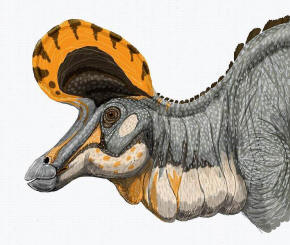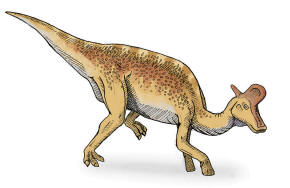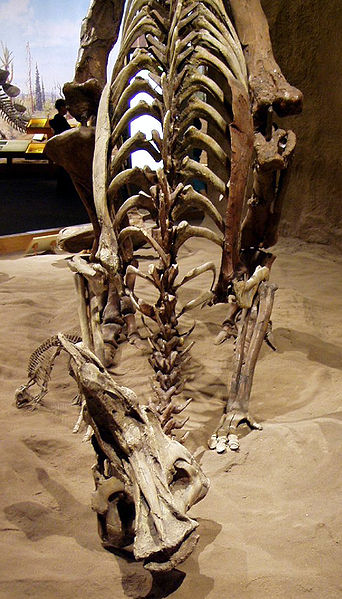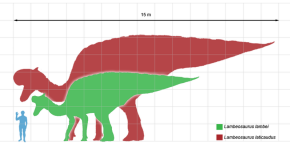|
Lambeosaurus was belatedly described in 1923 by
William Parks, over twenty years after the first material was studied by
Lawrence Lambe. The genus has had a complicated
taxonomic
history, in part because small-bodied crested hadrosaurids now recognized as
juveniles were once thought to belong to their own genera and
species.
Currently, the various skulls assigned to the
type species L. lambei are interpreted as showing age differences
and
sexual dimorphism.
Lambeosaurus was closely related to the better
known
Corythosaurus, which is found in slightly older rocks, as well as
the less well-known genera
Hypacrosaurus and
Olorotitan. All had unusual crests, which are now generally assumed
to have served social functions like noisemaking and recognition.
Description
Lambeosaurus, best known through
L. lambei, was quite
similar to the more famous
Corythosaurus in everything but the form of the head adornment.
Compared to Corythosaurus, the crest of
Lambeosaurus was
shifted forward, and the hollow nasal passages within were at the front of
the crest and stacked vertically. It also can be differentiated from
Corythosaurus by its lack of forking
nasal
processes making up part of the sides of the crest, which is the only
way to tell juveniles of the two genera apart: the crests took on their
distinctive forms as the animals aged.
In build,
Lambeosaurus was like other hadrosaurids, and could move
on both two legs and all fours, as shown by footprints of related animals.
It had a long tail stiffened by
ossified tendons that prevented it from drooping. The hands had four
fingers, lacking the
innermost finger
of the generalized five-fingered
tetrapod
hand, while the second, third, and fourth fingers were bunched together and
bore hooves,
suggesting the animal could use the hands for support. The
fifth finger was free and could be used to manipulate objects. Each foot
had only the three central toes.
The most distinctive feature, the crest, was different in the two
well-known species. In L. lambei, it had a hatchet-like shape when
the dinosaur was full-grown, and was somewhat shorter and more rounded in
specimens interpreted as females. The "hatchet blade" projected in front of
the eyes, and the "handle" was a solid bony rod that jutted out over the
back of the skull. The "hatchet blade" had two sections: the uppermost
portion was a thin bony "coxcomb"
that grew out relatively late in life, when an individual neared adulthood;
and the lower portion held hollow spaces that were continuations of the
nasal passages. In L. magnicristatus, the "handle" was greatly
reduced, and the "blade" expanded, forming a tall, exaggerated
pompadour-like crest. This crest is damaged in the best overall
specimen, and only the front half remains. In the lesser-known species "L."
laticaudus and
L. paucidens the crest is not currently known.
However, "L." laticaudus can be recognized by its great size and the
tall profile of its tail, which had elongated
chevrons and
vertebral spines like those of
Hypacrosaurus.
The Canadian species of
Lambeosaurus appear to have been similar
in size to Corythosaurus, and thus around 9.4 m long (31 ft), but
"L." laticaudus is estimated at between 15 m (50 ft) and 16.5 m (54.1
ft) long, with a weight of up to 23
metric tons
(25
tons).
Impressions of the
scales are known for several specimens; a specimen now assigned to
L.
lambei had a thin
skin with
uniform, polygonal
scutes
distributed in no particular order on the neck, torso, and tail. Similar
scalation is known from the neck, forelimb, and foot of a specimen of
L.
magnicristatus, whereas the tail of "L."
laticaudus had some
small bony bits embedded among large hexagonal and smaller rounded scales.
Species
Two species of
Lambeosaurus are currently confirmed valid, with a
third widely accepted and a fourth sometimes accepted.
L. lambei
Parks, 1923 is known from at least 17 individuals, with seven skulls and
partial skeletons and around ten isolated skulls.
L. magnicristatus
C.M. Sternberg, 1935 is only definitely known from two specimens, both with
skulls. Unfortunately, the majority of the articulated skeleton of the type
specimen has been lost. Many of the bones were extensively damaged by water
while in storage and were discarded before description; other portions of
this skeleton have also been lost. Its remains come from slightly younger
rocks than L. lambei. The specific name is derived from the
Latin magnus "large" and
cristatus "crested", referring to its bony
crest. Additionally,
Jack Horner has identified fragmentary lambeosaurine jaws from the
Bearpaw Formation of
Montana
as possibly belonging to
L. magnicristatus; these represent the first
lambeosaurine remains from
marine rocks. The large "L."
laticaudus Morris, 1981, known from
disassociated remains from several individuals, is accepted as a potential
species as well, although it could instead be a species of
Hypacrosaurus.
Its validity has been questioned by the describers of
Velafrons,
who find its remains to be nondiagnostic but distinct from their genus. The
specific name here is derived from the Latin latus "broad" and
cauda "tail".
L. paucidens (Marsh, 1889) is regarded as a
dubious name and is listed as
Hadrosaurus paucidens in the latest
review, although at least one author,
Donald F. Glut, accepts it as a species of
Lambeosaurus. In this
case, the specific epithet is derived from the Latin
pauci- "few" and
dens "tooth".
Paleoecology
Lambeosaurus lambei and
L. magnicristatus, from the
Dinosaur Park Formation, were members of a diverse and well-documented
fauna of
prehistoric animals that included such well-known dinosaurs as the
horned
Centrosaurus,
Styracosaurus, and
Chasmosaurus, fellow duckbills
Prosaurolophus,
Gryposaurus,
Corythosaurus, and
Parasaurolophus,
tyrannosaurid
Gorgosaurus, and
armored
Edmontonia and
Euoplocephalus. The Dinosaur Park Formation is interpreted as a
low-relief setting of
rivers and
floodplains that became more
swampy and
influenced by marine conditions over time as the
Western Interior Seaway
transgressed westward. The
climate
was warmer than present-day Alberta, without
frost, but
with wetter and drier seasons.
Conifers were apparently the dominant
canopy plants, with an
understory of ferns,
tree ferns, and
angiosperms. The anatomically similar
L. lambei,
L.
magnicristatus, and
Corythosaurus were separated by time within
the formation, based on
stratigraphy.
Corythosaurus fossils are known from the lower
two-thirds of the Formation, L. lambei fossils are present in the
upper third, and L. magnicristatus remains are rare and present only
at the very top, where the marine influence was greater.
Paleobiology
Feeding
As a hadrosaurid,
Lambeosaurus was a large bipedal/quadrupedal
herbivore, eating plants with a sophisticated skull that permitted a grinding motion
analogous to
mammalian
chewing. Its teeth were continually replaced and were packed into dental batteries
that each contained over 100 teeth, only a relative handful of which were in
use at any time. It used its beak to crop plant material, which was held in
the jaws by a cheek-like organ. Feeding would have been from the ground up to around 4
meters (13 ft) above. As noted by
Bob Bakker, lambeosaurines have narrower beaks than hadrosaurines,
implying that Lambeosaurus and its relatives could feed more
selectively than their broad-beaked, crestless counterparts.
Cranial crest
Like other
lambeosaurines such as
Parasaurolophus and
Corythosaurus,
Lambeosaurus had a distinctive crest on the top of its head. Its
nasal cavity ran back through this crest,
 |
| A life restoration of tall-crested Lambeosaurus
magnicristatus (Picture
Source) |
making it mostly hollow. Many
suggestions have been made for the function or functions of the crest,
including housing
salt
glands, improving the
sense of
smell, use as a snorkel or air trap, acting as a resonating chamber for
making sounds, or being a method for different species or different sexes of
the same species to recognize each other. Social functions such as
noisemaking and recognition have become the most widely accepted of the
various hypotheses.
The large size of hadrosaurid
eye sockets and the presence of
sclerotic rings in the eyes imply acute vision and
diurnal habits, evidence that sight was important to these animals. The
hadrosaurid sense of
hearing also appears to be strong. There is at least one example, in the
related
Corythosaurus, of a slender
stapes
(reptilian ear bone) in place, which combined with a large space for an
eardrum
implies a sensitive
middle
ear, and the hadrosaurid
lagena is
elongate like a
crocodilian's. This indicates that the auditory portion of the
inner ear
was well-developed. If used as a noisemaker, the crest could also have
provided recognizable differences for different species or sexes, because
the differing layouts of the nasal passages corresponding to the different
crest shapes would have produced intrinsically different sounds.
Return to the
Old Earth Ministries Online Dinosaur
Curriculum homepage.

Shopping
Bay
State Replicas - Skull
Black
Hills Institute -
|



